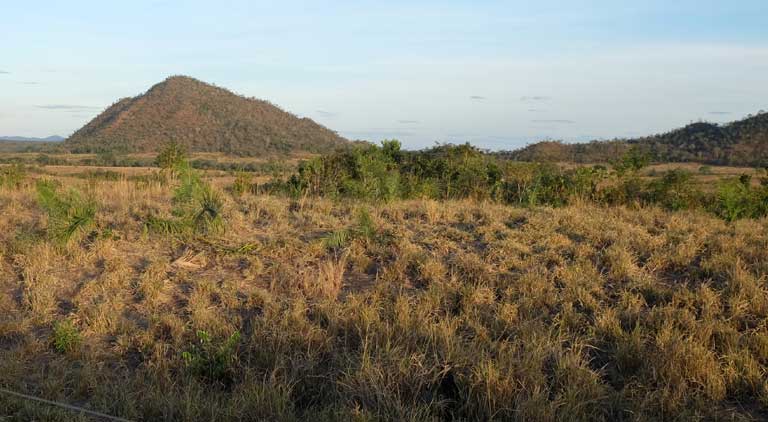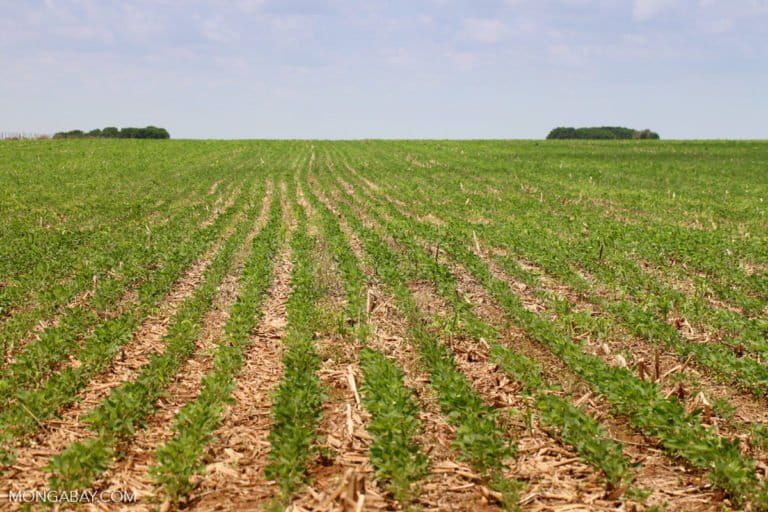- The meteoric growth of the soy industry, which cultivates the profitable bean to feed livestock and cultivated fish in both Brazil and internationally (especially in the UK and EU) is rapidly destroying critical biomes like the Cerrado, Brazil’s tropical savanna.
- But in December. Tesco, Nutreco, and Grieg Seafood launched a groundbreaking initiative aimed at reducing deforestation in the Cerrado by paying farmers to conserve native vegetation on their lands.
- The “Funding for Soy Farmers in the Cerrado Initiative” has so far managed to secure around US$13 million in pledges to incentivize farmers to avoid new deforestation, and instead grow on land that has already been transformed for agriculture. A mechanism for distributing the funds has yet to be established.
- The initiative’s goals align with those of the Cerrado Manifesto, a voluntary pact already signed by 60+ organizations to protect the Cerrado. Backers only want soy grown on the 38 million hectares already converted from savanna to agriculture. A sticking point: transnational commodities companies, like Cargill, haven’t signed on.

Three quarters of all soy produced globally provides feed for livestock, often at the cost of razing forests and other critical ecosystems, such as the Brazilian Cerrado — the world’s largest tropical savanna covering a fifth of the South American nation’s landmass. The Cerrado has been declared the country’s last agricultural frontier, as soy production explodes there. But it’s also been described as the largest frontier of habitat destruction on earth for the past 15 years on average, according to the World Wildlife Fund (WWF).
Now three big players in the seafood industry have announced a joint initiative to end soy-related deforestation in the Cerrado.
“The Funding for Soy Farmers in the Cerrado Initiative” (FSFCI) will provide savanna soy producers with financial incentives to ensure that future soy cultivation expansion in the biome only is carried out on existing agricultural lands. The measure is aimed at protecting the Cerrado’s remaining forest and other native vegetation above and beyond the percentage that already must be legally conserved on private lands under Brazil’s Forest Code, according to Andreas Kvame the CEO for Grieg Seafood.
FSFCI founding members include Nutreco, one of the world’s largest aquafeed producers; Grieg Seafood, a salmon farming firm based in Bergen, Norway; and Tesco, a large supermarket chain headquartered in Hertfordshire, England.
While the exact mechanism by which these funds will be disbursed has not yet been developed, Tesco is set to donate US$13.1 million to the initiative over the next five years, while Nutreco has pledged US$1.1 million annually over the same period; Grieg Seafood will contribute US$2.00 per ton of soy used annually by the firm in its fish feed, also covering the next five years.

A feasible zero deforestation plan, at last?
The program is different in one key way from the highly successful, though controversial, Amazon Soy Moratorium launched in 2006 to curb illegal deforestation in the rainforest biome. “The [Cerrado] initiative is aimed at eliminating not only illegal deforestation but also legal deforestation,” Nutreco Corporate Director of Sustainability Jose Villalon explained. “It would allow [the participation of] a farmer that has a deforestation permit [under Brazil’s Forest Code] — ensuring he goes through the whole legal framework — to commit to not deforest any more new land and get payment for not deforesting.”
In most of the Cerrado biome, private landowners under Brazil’s Forest Code can legally deforest up to 80% of their property, that’s as compared to Legal Amazonia, where only around 20% can be legally cleared.
Because farmers can legally deforest so much of their land already, offering positive incentives for producers rather than fines and other punitive measures is viewed by many analysts as essential to a successful ban of new deforestation caused by soy, says Rachael Garrett an assistant professor of environmental policy at ETH Zürich, who has studied Brazilian soy production for over a decade.
“Given the [large] area that is legally clearable in the Cerrado, there is some dissonance between what companies are asking [for] and what the legal framework of the country allows, which gives more credence to positive incentives,” Garrett says. “ I think that is why you see Nutreco’s incentive happening in this format, and that really has to be viewed in the context of what will make zero deforestation policies politically feasible in the region.”

Feeding the soy deforestation problem
Global production of soy has doubled — and even tripled in some countries — since 2000, driven in no small part by an increased demand for meat globally. In Brazil, over the last eleven years, more than 2 million hectares (7,722 square miles) of forest and native vegetation — an area the size of El Salvador — has been cleared to grow soy. More than 80 percent of that soy-related deforestation happened in the Cerrado biome, the preservation of which is vital for both its immense biodiversity, and for its extensive soil and plant carbon reservoir, a hedge against the escalating climate crisis.
However, more than half of the biome’s original vegetation of 2 million square kilometers (772,005 square miles) has already been converted to agriculture, and only 20 percent remains fully intact — much of it in the Cerrado’s Northeast, an area currently at the frontier of soy expansion. Importantly, there are very few federal or state conservation areas in the region to blunt that expansion, so preservation is largely dependent on private landholder cooperation.
“The Cerrado has much less protection legally, has fewer protected areas, and more of it has been converted; the remaining areas are much less protected and much more vulnerable,” says Garrett. “This is what makes it the most ‘at threat’ region in the soybean sector in the world and critically important in terms of its conservation value.”
About three quarters of all soy production globally goes to animal feed, with the remainder used for biofuel and food production. Soya is a prime ingredient of cattle, pork, and poultry feed, and also, increasingly important to the aquaculture industry. The Food and Agriculture Organization of the United Nations (FAO) estimates that fish consumption of soy will grow by 1.2 percent annually over the next decade.
Aquaculture feed — used to farm salmon, for example — was historically made out of other fish. But in recent years, consumer concern over overfishing caused feed companies to seek out a sustainable alternative. They found it in the high-protein legume. However, soy was no silver bullet; it came with its own set of issues. “[I]ncreased demand for soy was fueling deforestation: trying to solve one sustainability challenge at sea, created another on land,” says Villalon.

Seeking soy solutions
In October 2017, Nutreco was one of 23 founding signatories of the “Business Statement of Support to the Cerrado Manifesto.” The manifesto, launched in September 2017, was a call for action from more than 60 NGOs, foundations, and scientific institutes in Brazil to halt conversion of native vegetation in the biome. Today, the Busniess Statement of Support is endorsed by almost 140 companies. But, despite such commitments on paper, little has been achieved on the ground to halt deforestation. Importantly, transnational commodities traders like Cargill, ADM and Bunge have so far failed to support the manifesto.
If Nutreco, Tesco and Grieg Seafood “succeed with this [new] initiative, this is going to be one of the greatest stories to be told this year,” says Frederico Machado, a public policy specialist in WWF-Brasil’s Food and Agriculture program. “2020 is the deadline for commitments made under the New York Declaration on Forests, the Consumer Good Forum and many other individual sector commitments. We hope the [three lead organizations] will get others on board and that the implementation really achieves its goal of stopping deforestation from soy.”
The new fund is currently designed as a five-year commitment from the three companies. Nutreco estimates around US$250 million in funding would be needed over a five-year period to achieve the goal of ending soy-associated deforestation and habitat conversion in the Cerrado. Those companies that have signed a statement of support for the Cerrado Manifesto could join the fund, Villalon says, as could international soy-value chain companies, foundations and governments.
The first of its kind to offer major financial incentives to Cerrado soy farmers, this new initiative follows on the tail of other industry-led efforts aimed at protecting the biodiversity and carbon locked up in the Cerrado: in September, Tyson Foods, as part of its global expansion, joined the Roundtable on Responsible Soy, one of the largest international soy certifying groups. Tyson pledged to only source sustainable soy from Brazil. In December, a group known as the “Aquaculture Dialogue on Sustainable Soy Sourcing from Brazil” established terms for tracing sustainable soy supply chains for salmon production.
Garrett cautions that these kinds of incentives are only effective if scaled up to include more producers, commodities companies and retailers, and designed to operate for the long-term. Such policies must also clearly spell out to all involved parties the exclusion of forest and native vegetation conversion from soy production expansion.
“I think it’s fantastic that more and more companies are trying to tackle these issues in the Cerrado, but efforts to improve private sector governance there should be viewed as a work in progress and there should be systematic evaluation of what works best rather than an all in one approach,” Garrett concludes. “In order for these things to [be successful] they have to work with local stakeholders and officials to increase enforcement of existing laws and include farmers in the policy design and decisions.”
Banner image caption: Soy silos in the Brazilian Cerrado. Image by Sarah Sax / Mongabay.
FEEDBACK: Use this form to send a message to the author of this post. If you want to post a public comment, you can do that at the bottom of the page.
